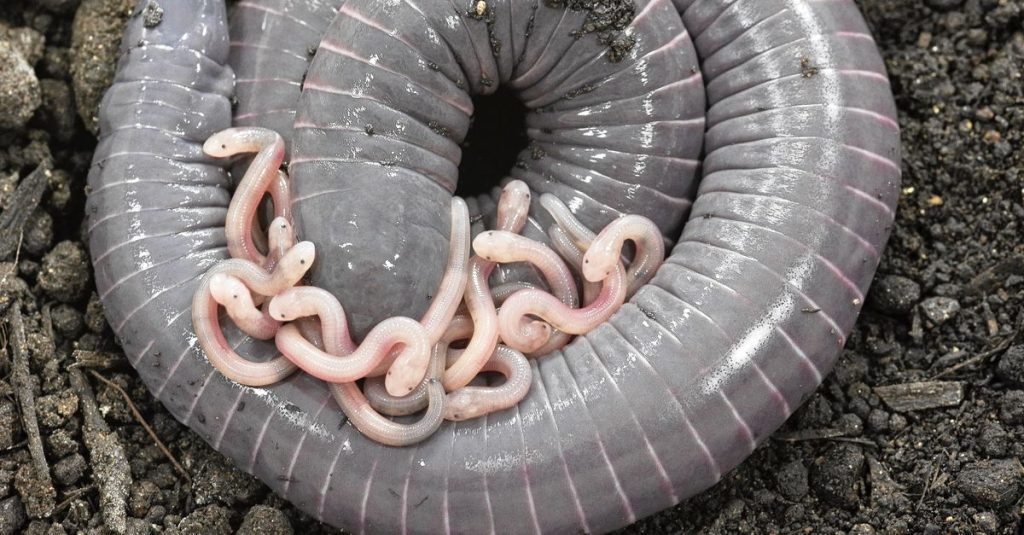It's an amazing combination. Biologists already knew that female caecilians (Siphonops annularis) feeds its young through the skin, but recent research now points to another method of feeding: milk from the mother's cloaca. Cloacas are openings in the body that secrete feces, urine, semen, and eggs. The fact that caecilians, in addition to mammals, also feed their young with milk, sheds new light on the evolution of this species. An international team reports this week in Sciences.
In most vertebrates, such as birds, reptiles, amphibians, and fish, the young depend on food from the environment. Mammals do it differently: they provide milk food. In recent years, evidence has been mounting that some non-mammalian organisms – such as some spiders, cockroaches, fish and birds – can also produce milky feeders.
Recent research adds a new non-mammal to the list: caecilians. Until recently, these amphibians were thought to feed on their young only through the skin; During rearing, the mother develops an oily outer layer on her skin that serves as food for her young. But it now appears that the mother also secretes milky substances from the cloaca on the back of her body, a behavior previously unknown in amphibians.
Caecilians are found in tropical regions, especially in northern South America. They look very much like earthworms, with an elongated body and no legs. “It is one of the least understood vertebrates,” says co-author Carlos Jared, a Brazilian naturalist. This is because they spend a large part of their lives underground and are therefore difficult to study.
However, the research team was able to collect 16 female salamanders and their young from under the forest floor on cocoa plantations in northeastern Brazil. They then transferred the mothers, each with four to 13 babies, to the laboratory for observation. There they discovered something wonderful: during the time the cubs spent with their mother, their stomachs were constantly full. The research team suspected that they were fed fluid from the cloaca.
To test their hypothesis, the scientists made 242 hours of video recordings. Mothers usually lie in a curled position with their young on their backs: especially around the tip of the body and the cloaca. The caecilians touched and bit the cloaca, producing high-pitched squeaking sounds. These sounds seem to encourage the mother to raise her buttocks, exposing the cloaca and releasing a clear fluid, which the authors describe as “milk.”
The team confirmed that the pups were fed milk several times a day, after which they became less active after each milking session and “displayed visible satiety on the abdomen.”
It turns out that salamander milk is rich in fats and carbohydrates, just like mammalian milk. This milk nutrition, combined with protein-rich skin nutrition, is essential for the rapid growth of the young. The difference between the two forms of feeding is in the frequency and method of presentation. Mothers feed the young with milk daily, while skin feeding is irregular.
Coordinated behavior
Milk feeding also requires coordinated behavior between mother and pups, where “begging behavior” plays a role: both the touch of the cloaca and the whistling sounds of the pups stimulated the mother to release milk. This begging behavior is not necessary for skin nourishment.
In addition to caecilians, there are hundreds of other species in the same family, some of which do not lay eggs but give birth to live young and also produce milk. The research team suggests that the strange combination of egg laying and milk production may be an intermediate stage in the transition from one method of birth to another.
“But perhaps mothers are very interested in their young and use different feeding methods,” says Marvali Weick, an American zoologist and professor at the University of Berkeley, who was not involved in this study. “This discovery is just a starting point: it is still unclear whether other species do this, and how, why, when and where this milk comes from in evolutionary terms.”

“Coffee buff. Twitter fanatic. Tv practitioner. Social media advocate. Pop culture ninja.”











More Stories
Which can cause an increase in nitrogen.
The Central State Real Estate Agency has no additional space to accommodate Ukrainians.
The oystercatcher, the “unlucky national bird,” is increasingly breeding on rooftops.